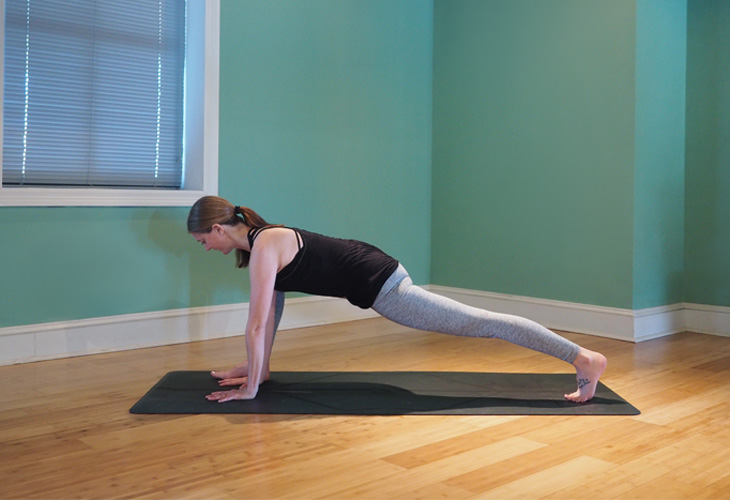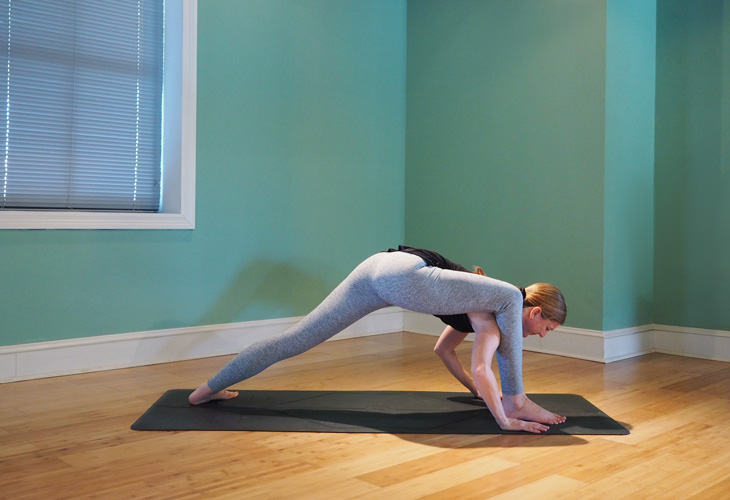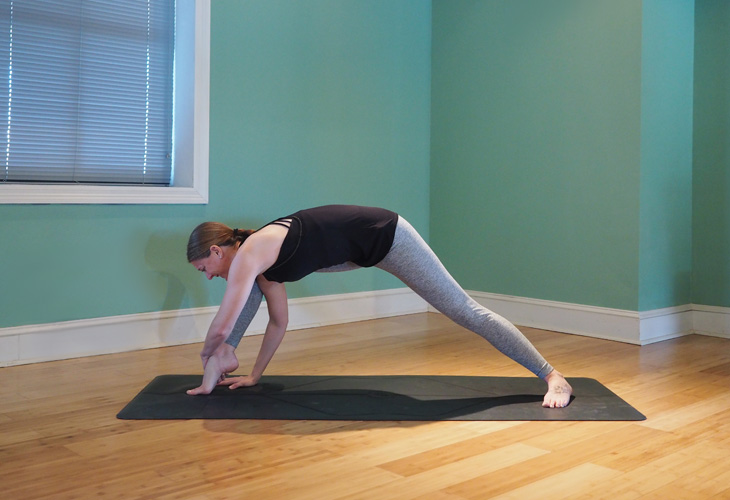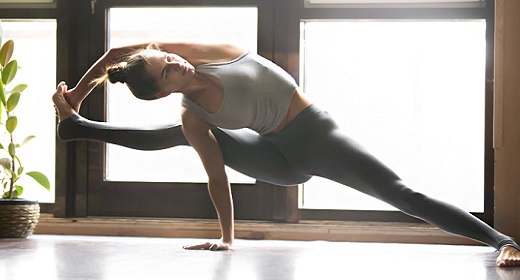by Tonya Wetzel: There’s no getting around it, Visvamitrasana (Visvamitra’s Pose) is a hard posture…
It requires full body integration and cooperation, flexibility, open shoulders and side body, core and arm strength, and above all, patience.
Some days my body gracefully unfolds into the pose. Other times, I’m more like my clumsy Great Dane who falls over every time he stretches.
When I do manage to make it into Visvamitrasana I feel pretty damn amazing – like I can conquer anything that life might throw my way.
What Does Visvamitrasana Mean?
Visvamitrasana is named after a celebrated Hindu sage with a somewhat unusual history. Visvamitra was born a warrior but eventually became king. While hunting one day, he discovered a sacred and magical cow that belonged to the Brahman sage Vasistha.
Visvamitra first tried to barter for the cow, but it didn’t work. So he tried to take it by force. Although unsuccessful at both, he was impressed with the power of the sage Vasistha. This experience led him on a quest to become a Brahman sage himself.
According to B.K.S. Iyengar in his book Light on Yoga, only after devoting himself to living a life of piety and asceticism did Visvamitra become a Brahman sage and find what he was truly seeking.
This is the perfect namesake for this pose, as you cannot force yourself into it. It is only after time, effort, energy, and likely several tries that you can enjoy Visvamitrasana.
How to Prepare for Visvamitrasana:
Since Visvamitra’s Pose involves full body integration, it’s best to try it toward the end of your practice once your body is warm, stretched out, open, and fully awake.
Be sure to include several rounds of both Sun Salutations A and B along with the following poses before moving onto Visvamitrasana:
- Side Plank (Vasisthasana)
- Triangle Pose (Trikonasana)
- Bound Side Angle Pose (Baddha Parsvakonasana)
- Pyramid Pose (Parsvottanasana)
- Cow Face Pose (Gomukhasana)
- Half or Full Split/Monkey Pose (Ardha Hanumanasana/Hanumanasana)
- Revolved Head-to-Knee Pose (Parivrtta Janu Sirsasana)
Here’s How to Safely Practice Visvamitrasana Step-by-Step:
1. Start in Lizard Pose (Utthan Pristhasana)

Let’s try it:
- From Down Dog (Adho Mukha Svanasana) bring your hands closer together so that the tips of your thumbs are touching
- Spread your fingers wide
- Step your right foot forward to the outside of your right hand
- Activate your left leg while pushing firmly into the mat
- Send your gaze (drishti) to the top of your mat while keeping a neutral neck
- Pull your right hip back slightly to deepen the stretch
2. Slide Your Right Shoulder Under Your Knee

Let’s try it:
- Slide your right shoulder beneath your right knee creating compression between the two
- Send your right hand to the outside of your right foot
- Plant your left foot on the floor like in Warrior II – evenly press into your toes and heel as well as the inside and outside of your foot
- Return your gaze to the front of the mat if you moved it while getting into position
- Engage your major bandhas and take a few breaths
3. Grab Your Foot

Let’s try it:
- Shift your weight into your right hand and left foot
- Lift your right heel and come onto the toes of your right foot
- Grab your right foot with your left hand reaching across the top of your foot to grab the pinky toe edge
- Firmly press your inner right thigh into your right arm to find stability
4. Extend Your Leg

Let’s try it:
- Slowly extend your right leg out straight
- Send your left arm toward the front of your mat and over you head and chest
- Keep your right leg and arm pressing into each other to keep your leg from slipping
- Externally rotate your right arm to help open your right shoulder
- Pull your left side body and rib cage up and back to open your chest and find a gentle twist
- Lengthen your body from your left foot all the way to your floating right toes
- Point or flex your right foot – try both to see how you feel most stable
5. Release and Repeat on the Opposite Side
After holding the pose for several breaths and enjoying the full body stretch and feeling of strength, bend your right leg, and lower your foot to the ground to find Lizard Pose again.
Release and return to Down Dog, and take a few breaths there or release into Child’s Pose (Balasana) before trying the other side.
Visvamitrasana: A Pose of Many Benefits
Visvamitrasana has many benefits including building strength and flexibility, opening the side body, and stretching the legs and hips in a way not found in many other poses. It builds mindfulness, full body integration, and balance.
Above all, Visvamitrasana makes you feel like a badass . . . and we could all use a bit more of that in our lives.
This pose reminds me what asana practice is all about. It’s not about making pretty shapes with my body or if I can or can’t do a challenging pose today. Rather, it’s about finding the balance between strength and flexibility, effort and ease, joy and frustration, and using these skills for self-transformation both on and off the mat.

















































